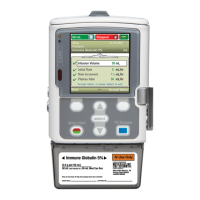
Do you have a question about the Smiths Medical CADD Solis 2100 and is the answer not in the manual?
| Reservoir Capacity | 100 mL |
|---|---|
| Delivery Modes | Continuous, Intermittent, PCA |
| Alarms | Air-in-line, occlusion, low battery, end of program, reservoir empty, system error |
| PCA Dose | 0.1 to 9.9 mL (in 0.1 mL increments) |
| Bolus Dose | 0.1 to 9.9 mL (in 0.1 mL increments) |
Contact information for Smiths Medical's US distribution.
Contact information for Smiths Medical's European distribution.
Critical safety and operational information regarding pump design.
Details regarding the pump's warranty coverage and limitations.
Specific conditions where the pump should not be used.
Safety precautions and potential hazards associated with pump use.
Precautions to avoid pump damage and ensure proper operation.
Describes the different modes of drug delivery supported by the pump.
Illustrates the front and rear views of the CADD®-Solis pump.
Details the programmable ranges and increments for pump settings.
Provides nominal specifications for the pump's classification, size, and weight.
Lists pump alarms, delivery rates, pressure thresholds, and detector sensitivities.
Specifies occlusion alarm times and maximum bolus volumes at occlusion.
Outlines the pump's accuracy specifications and factors affecting it.
Details programming units, concentration, reservoir volume, and delivery limits.
Covers settings like KVO rate, bolus interval type, and alarm configurations.
Lists compatible tubing sets and information on software upgradeability.
Recommended storage conditions and factors affecting battery life.
Describes pump battery status indicators and proper disposal instructions.
Describes the pump housing, internal circuitry, and external connection ports.
Explains the linear peristaltic mechanism and its operational cycle.
Details battery-backed memory and the pump's power circuitry.
Explains the LCD display, LED indicators, and audible alarm system.
Covers fluid path behavior, occlusion handling, and sensor circuits.
Explains the system fault alarm, its indicators, and event reporting.
Provides procedures for cleaning and disinfecting the pump and its accessories.
Recommends annual procedures for verifying pump function and accuracy.
Guidelines for visually and mechanically inspecting the pump for damage.
Procedures for testing pump operations, alarms, and indicators.
Tests the pump's response to downstream and upstream occlusions.
Procedures for testing the gravimetric and volumetric accuracy of the pump.